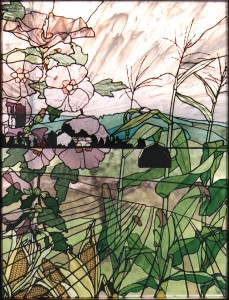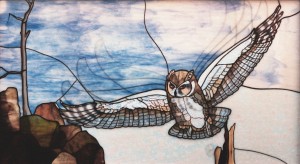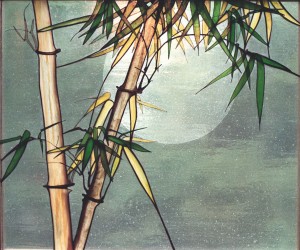TECHNIQUES
| Robert Oddy: Stained Glass Plating Techniques |
| Lecture at Warner-Crivellaro Stained Glass |
| Christie Wood |
This is the text of an article that appeared in the Fall 1997 issue of Common Ground: Glass, published by IGGA (International Guild of Glass Artists).
On May 31, 1997, a group of bungians were privileged to meet Robert (Bob) Oddy, the stained glass artist whose wonderful plating techniques have caused quite a stir on the [email protected] glass newsgroup [to subscribe, email “Subscribe” to [email protected] correspond with the group by emailing to [email protected]]. If you haven’t yet checked out Oddy’s work, it may be found on his web page.
What started out as a Philadelphia-area bungi group Saturday shopping trip up to Warner-Crivellaro Stained Glass’ warehouse in Allentown, PA, turned into quite an educational trip for all. Thanks to Hilary Bobker (bungian wizard) who organized the trip, and got the ball rolling. But special thanks go to Charles and Marianne Warner, owners of Warner-Crivellaro, who managed with only a half week’s notice to contact Robert Oddy and arrange for him to give the lecture. Warner-Crivellaro graciously paid for Oddy’s plane ticket and overnight stay, just so that we would have the benefit of hearing this artist present his works and techniques.
A few of us carpooled up to Allentown. When we arrived at 10:00 a.m., several other bungians were already present. More and more people showed up throughout the day. In total, there were 34 people present for the lecture. And, of those, twelve were bungians! Marianne Warner and her staff provided us all with a beautiful spread of coffee, tea, pink lemonade, iced tea, danish, bagels & spreads, home-baked coffee cakes and fresh fruit. Warner-Crivellaro hosts Saturday stained glass techniques lectures/demonstrations throughout the year, but this one surpassed everyone’s expectations. Warner’s regular Saturday demonstrator, Angelo Grello, started off the lecture with an introduction of the special guest of honor, Robert Oddy. Throughout the day, Angelo and Oddy did demonstrations and lectures about glass plating techniques. And Charles Warner hosted a guided tour through the Warner-Crivellaro showrooms, warehouses, and manufacturing facilities (they manufacture cast lead and pewter figurines and filigrees for stained glass work).
Robert Oddy is a self-taught stained glass artist who began his trip into glass work in 1983. He uses copper foil technique exclusively and works out of his home, getting client referrals through architects and builders. All of his works are original designs, many of which feature stained glass in combination with other materials, including wood, tree bark, rocks and geodes. The first stained glass piece he ever constructed was a kaleidoscope. He does all his design work by hand, sketching everything after researching the subject matter.
 Oddy brought his photograph album, which shows many more installations than are listed on his web site. But, the highlight of the day was the fact that he had been able to obtain and bring with him one of the panels featured on his web site, the one titled “Serpent,” which features the full moon and a boa constrictor in a bamboo forest. This piece also features wood and tree bark fitted into the panel.
Oddy brought his photograph album, which shows many more installations than are listed on his web site. But, the highlight of the day was the fact that he had been able to obtain and bring with him one of the panels featured on his web site, the one titled “Serpent,” which features the full moon and a boa constrictor in a bamboo forest. This piece also features wood and tree bark fitted into the panel.
Integrating real tree bark into a stained glass panel involves treating the wood to minimize shrinkage and to stop deterioration of the material. To do this, the bark is saturated in [carpenter’s] glue, allowed to dry, and then the process repeated four or five times. The bark is used as part of the framing structure. To join the bark piece, duplicate the bark’s form in wood for the back part of the framing, notching out a channel for the glass. Then sandwich the glass panel between the two pieces of wood and connect the pieces of wood using dowels or screws.
The most intriguing part of the lecture was about plating, also called overlay. Plating involves using more than one layer of stained glass, each layer being soldered on top the other to give various effects. It has been practiced since late last century when Louis Comfort Tiffany and John La Farge did a lot of plating. Stained glass plating looks great when viewed from the front, but pretty awful when viewed from the back. This is because most plating occurs on the back surface of the panel.
Why do plating?
There are several reasons:
It makes solder lines or lead lines less distinct. It gives a sense of distance to the piece. To get this effect of distance the layer closest to the viewer should be a dense, thick opal glass. Dense glass diffuses the light passing through the layers and gives the desired diffused look. Many Tiffany panels feature this effect.
To add shading to a piece. You need a relatively dense glass, otherwise the line will be too pronounced.
 To modify glass colors and textures. By plating glass together you are not restricted by the color or texture selection available at the retail store. To superimpose images atop each other. A good example of this is Oddy’s “Central New York” panel on his web site.
To modify glass colors and textures. By plating glass together you are not restricted by the color or texture selection available at the retail store. To superimpose images atop each other. A good example of this is Oddy’s “Central New York” panel on his web site.
To superimpose images. Do the background first, then the plating layer is superimposed on top. To create sculptural effects without leadlines, such as the moon in the “Serpent” panel.
To create a ‘ragged’ or faceted effect. This is a three-dimensional effect created by having multiple layers of glass placed so that as the plated layers become more intense, they absorb more light and cast shadows onto other parts of the panel. You can also vary the angle of the plated glass on the top layers to make them more rough in appearance, such as the tree in the “Serpent” panel.
There are different plating techniques which can be used to achieve these effects:
When designing a plated panel, first draw the base design, then decide which segments of the design to plate. Trace these onto onion skin paper, cut them out and lay them on top of the cartoon to get some idea of what the plating effects will be. Build the multi-plate section as a separate panel, then solder it into place atop another panel. Build a base layer and then plate layers directly to it. Oddy [used] a bandsaw [ … ] on “Serpent” to cut some of the bamboo leaf insert points into the joint between the moon and the clear plate glass layers. Use very thin copper foil so the foil on the plated glass doesn’t show  up through the top layers of glass. Oddy uses various thicknesses of copper foil and sometimes even reduces the copper foil line with a razor blade to get the thinnest possible line for certain effects (see “Owl” on his web page). Oddy uses regular water-soluble soldering flux and avoids using paste flux since it is more difficult to clean. You must thoroughly wash flux off the panel as each layer is built. Do not solder a high-profile finished solder bead on the area of the panel which will be plated. This is so the solder doesn’t raise the plane of the glass. If applying patina to the project, you must patina the plated layer prior to soldering it onto the base.
up through the top layers of glass. Oddy uses various thicknesses of copper foil and sometimes even reduces the copper foil line with a razor blade to get the thinnest possible line for certain effects (see “Owl” on his web page). Oddy uses regular water-soluble soldering flux and avoids using paste flux since it is more difficult to clean. You must thoroughly wash flux off the panel as each layer is built. Do not solder a high-profile finished solder bead on the area of the panel which will be plated. This is so the solder doesn’t raise the plane of the glass. If applying patina to the project, you must patina the plated layer prior to soldering it onto the base.
Some problems involved with plating:
You must be able to cut accurately. Some layers have to fit on top of each other very accurately. There can be a problem of moisture buildup between layers. Thoroughly clean and dry (with a hair dryer) each layer as it is built. Venting between layers allows moisture to escape. To build vent areas, don’t completely solder all areas. Put a bit of Vaseline on the top- and bottom-most points of the plated piece. Then solder. The solder will not stick to the Vaseline and will leave small vent holes for moisture to escape. Flux can ‘spit’ between layers when soldering. If this happens, you must desolder the piece, clean it, and try again. Multi-layered plating makes it nearly impossible to lay the panel flat on a table. You must support the various layers of glass from beneath to distribute the weight of the panel equally and keep it level during soldering. With plating in only some areas of a panel (as opposed to completely plating the entire panel), the weight of the panel is not carried directly through the vertical plane of the glass. You must plan weight distribution throughout the panel when plating. If the shapes are more complex (i.e., more curves and smaller pieces), it is more likely to have the necessary strength. Long horizontal planes are most at risk of bowing. Add curves to the design for strength. Use Re-Strip® inside solder lines. If you find the bottom portion of the panel is a single layer, while the upper portions of the panel are multi-layer, you have a serious weight distribution problem. To solve this, plate clear sheet glass to the bottom section to give it the necessary strength to support the weight of the plated glass above it. Glazing into a frame is more difficult with plated glass. Carve away parts of the wooden frame as needed in order to fit the plated sections into the frame.
A lot of plated stained glass pieces do not have a set pattern due to the complexity of the design. Most plated panels have the plated sections designed while the panel is under construction. Light boxes or a strong natural light source such as a good window are crucial for deciding on particular texture/color combinations used in plating. To try your first plating experiment, come up with a base design and then try out additional layers. Or you can plate onto an existing panel. Reduce the solder on the back of the panel to a flat solder line. Then cut the plating pieces and solder them onto the back of the panel.
 Other questions about how Oddy achieved some of the effects shown on panels on his web site were explained during the lecture. “Owl” (which features an owl flying through the air with wings outstretched) achieves the ‘wing beat’ effect by plating clear glass pieces to the back of the panel. Each layer uses smaller and smaller widths of copper foil, giving the illusion that the wing beats are fading into the background. “Bamboo” was created in 1983 and was Oddy’s first plated piece. “Serpent” involved first constructing the snake, using children’s picture books as background information in order to get the snake’s anatomy correct. Pay particular attention to perspective when constructing naturalistic pieces, such as are shown on Oddy’s web site.
Other questions about how Oddy achieved some of the effects shown on panels on his web site were explained during the lecture. “Owl” (which features an owl flying through the air with wings outstretched) achieves the ‘wing beat’ effect by plating clear glass pieces to the back of the panel. Each layer uses smaller and smaller widths of copper foil, giving the illusion that the wing beats are fading into the background. “Bamboo” was created in 1983 and was Oddy’s first plated piece. “Serpent” involved first constructing the snake, using children’s picture books as background information in order to get the snake’s anatomy correct. Pay particular attention to perspective when constructing naturalistic pieces, such as are shown on Oddy’s web site.
If you want more information, please visit Robert Oddy’s web site, or contact Charles Warner at Warner-Crivellaro, 1855 Weaversville Road, Allentown, PA 18103 phone 1-800-523-4242 or 610-264-1100.
web: www.robertoddy.com | mail: [email protected] | phone: (315) 200-2260
